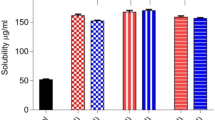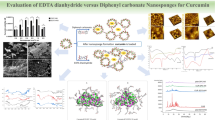Abstract
The aim of this work was to increase the solubility, stability and permeation of resveratrol by complexation with cyclodextrin-based nanosponges (NS). Nanosponges are recently developed hyper-cross-linked cyclodextrin polymers nanostructured to form three-dimensional networks; they are obtained by reacting cyclodextrin with a cross-linker such as carbonyldiimidazole. They have been used to increase the solubility and stability of poorly soluble actives. This study aimed at formulating complexes of resveratrol with β-cyclodextrin nanosponges in different weight ratios. DSC, FTIR and X-ray powder diffraction (XRPD) studies confirmed the interaction of resveratrol with NS. XRPD showed that the crystallinity of resveratrol decrease after encapsulation. The particle sizes of resveratrol-loaded NS are in between 400 to 500 nm with low polydispersity indices. Zeta potential is sufficiently high to obtain a stable colloidal nanosuspension. TEM measurement also revealed a particle size around 400 nm for NS complexes. The in vitro release and stability of resveratrol complex were increased compared with plain drug. Cytotoxic studies on HCPC-I cell showed that resveratrol formulations were more cytotoxic than plain resveratrol. The permeation study indicates that the resveratrol NS formulation showed good permeation in pigskin. The accumulation study in rabbit mucosa showed better accumulation of resveratrol NS formulation than plain drug. These results signify that resveratrol NS formulation can be used for buccal delivery and topical application.













Similar content being viewed by others
References
Trotta F, Tumiatti W. Cross-linked polymers based on cyclodextrin for removing polluting agents. WO 03/085002; 2003.
Trotta F, Cavalli R. Characterization and applications of new hyper-cross-linked cyclodextrins. Compos Interface. 2009;16:39–48.
Cavalli R, Trotta F, Tumiatti W. Cyclodextrin-based nanosponges for drug delivery. J Incl Phenom Macrocycl Chem. 2006;56:209–13.
Lamuela-Raventos RM, Romero-Perez AI, Andrew L, Waterhouse M, de la Torre-Boronat C. Direct HPLC analysis of cis- and trans-resveratrol and piceid isomers in Spanish red Vitis vinifera wines. J Agric Food Chem. 1995;43:281–3.
Romero-Pérez AI, Ibern-Gómez M, Lamuela-Raventós RM, de la Torre-Boronat C. Piceid the major resveratrol derivative in grape juices. J Agric Food Chem. 1999;26:1533–6.
Dixon RA. Natural products and plant disease resistance. Nature. 2001;411:843–7.
Bertacche V, Lorenzi N, Nava D, Pini E, Sinico C. Host–guest interaction study of resveratrol with natural and modified cyclodextrins. J Incl Phenom Macrocycl Chem. 2006;55:279–87.
Haunstetter A, Izumo S. Apoptosis: basic mechanisms and implications for cardiovascular disease. Circ Res. 1998;82:1111–29.
Renaud S, De Lorgeril M. Wine, alcohol, platelets, and the French paradox for coronary heart disease. Lancet. 1992;339:1523–6.
Chun JC, Wei Y, Yu-Cai F, Xin W, Ji-Lin L, Wei W. Resveratrol protects cardiomyocytes from hypoxia-induced apoptosis through the SIRT1–FoxO1 pathway. Biochem Biophys Res Commun. 2009;378:389–93.
Wenzel E, Somoza V. Metabolism and bioavailability of trans-resveratrol. J Pharm Sci. 2005;49(5):472–81.
Pace A, Rounova CR, Hahn O. Wines and grape juices as modulators of platelet aggregation in healthy human subjects. Clin Chim Acta. 1996;246:163–82.
Jang M, Cai L, Udeani G, Slowing KV, Thomas CF, Pezzuto JM. Cancer chemopreventive activity of resveratrol, a natural product derived from grapes. Science. 1997;275:218–20.
Clement MV. Chemopreventive agent resveratrol, a natural product derived from grapes, triggers CD95 signaling-dependent apoptosis in human tumor cells. Blood. 1998;92:996–1002.
Bertelli A. Plasma and tissue resveratrol concentrations and pharmacological activity. Drugs Exp Clin Res. 1998;24:133–8.
Kopp P. Resveratrol, a phytoestrogen found in red wine. A possible explanation for the conundrum of the 'French paradox. Eur J Endocrinol. 1998;138:619–20.
Chan MMY. Antimicrobial effect of resveratrol on dermatophytes and bacterial pathogen of skin. Biochem Pharm. 2002;63:99–104.
Paola V, Stefano S, Gianni G, Cristiana G, Nicola C. Bioavailability of trans-resveratrol from red wine in humans. J Pharm Sci. 2005;49(5):495–504.
Lu Z, Cheng Bo, Hu Yeli, Zhang Youhoung, Zou Guolin. Complexation of resveratrol with cyclodextrins: solubility and antioxidant activity. Food Chemistry. 2009;113(1):17–20.
Lucas-Abellán C, Fortea I, López-Nicolás JM, Núñez-Delicado E. Cyclodextrins as resveratrol carrier system. Food Chem. 2007;104(1):39–44.
Vavia PR, Swaminathan S, Trotta F, Torne SJ. Formulation of β-cyclodextrin based nanosponges of itraconazole. J Incl Phenom Macrocycl Chem. 2007;57(1–4):89–94.
Swaminathan S, Pastero L, Serpe L, Troota F, Vavia P, Aquilano D, et al. Cyclodextrin-based nanosponges encapsulating camptothecin: physicochemical characterization, stability and cytotoxicity. Eur J Pharm Biopharm. 2009;74:193–201.
Torne SJ, Ansari KA, Vavia PR, Trotta F, Cavalli R. Enhanced oral paclitaxel bioavailability after administration of paclitaxel-loaded nanosponges. Drug Deliv. 2010;17(6):419–25.
Hoogstrate AJ, Senel S, Cullander C, Verhoef J, Junginger HE, Boddè HE. Effects of bile salts on transport rates and routes of FITC labelled compounds across porcine buccal epithelium in vitro. J Control Release. 1996;40:211–21.
Hoogstraate AJ, Senel S, Cullander C, Verhoef J, Junginger HE, Hui H, et al. High-performanceliquid chromatography spectrometric analysis of trans-resveratrol in rat plasma. J of Chromatography B. 2006;832:177–80.
Cilurzo F, Minghetti Paola, Sinico C. Newborn pig skin as model membrane in vitro drug permeation studies. AAPS PharmSciTech. 2007;8(4):E1–4.
Acknowledgements
The Ministry of Education, University and Research (MIUR) Italian government and University grant commission (UGC) India supported this work.
Author information
Authors and Affiliations
Corresponding author
Rights and permissions
About this article
Cite this article
Ansari, K.A., Vavia, P.R., Trotta, F. et al. Cyclodextrin-Based Nanosponges for Delivery of Resveratrol: In Vitro Characterisation, Stability, Cytotoxicity and Permeation Study. AAPS PharmSciTech 12, 279–286 (2011). https://doi.org/10.1208/s12249-011-9584-3
Received:
Accepted:
Published:
Issue Date:
DOI: https://doi.org/10.1208/s12249-011-9584-3




